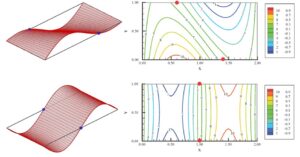Summary
The project aims to develop a general framework for the analysis and design of functional components of buildings and structures, where such components achieve large shape changes (morphing) via buckling. The shape changes are optimised, e.g. to reduce energy consumption by minimising solar radiation loads or maximising natural air ventilation. The project will develop innovative building technology solutions to reduce Australia’s energy consumption, and provide new domestic and global market opportunities in the high-tech manufacturing sector.
This Project is supported by the ARC Discovery Project DP170104916.
Chief investigators
- Prof Kim Rasmussen
- Prof Liyong Tong
- Dr Mike Bambach
- Dr Mani Khezri
PhD students and graduates:
- Ms Yang Hu
- Mr Hongzhi Zhang

Project outcomes and significance
An innovative concept has been developed in which a plate element is supported at one or several discrete points to enable loads to be applied which exceed the load at which the plate would buckle had discrete supports not been applied. In response to external stimuli, the discrete supports are then removed whereby the element snaps into a buckled configuration and instantaneously enacts a large shape change.
Separate optimisation studies have been completed on plate elements where material is progressively removed from the plate to maximise the area or volume of the opening in the buckled configuration. Complementary experiments were performed for proof of concept in which piezo electric actuators were used to apply compressive stress to the plate to produce buckling. Various materials were investigated including metals and polymers.
Frame-type structures are being investigated because of their propensity to deflect laterally and undergo large deflections when subjected to in-plane bending. Optimisation studies have been performed to determine the shape of the elements of the frame that maximises the lateral deflection for given applied moment. Currently, innovative solutions are being investigated for using buckling to activate energy-efficient façade components in response to external thermal loading.

Publications
- Y. Hu, M. Khezri and K.J.R. Rasmussen, “Analytical buckling solutions for Levy-type plates with edge and interior point-support(s)”, Thin-Walled Structures, 2019, Vol. 145, doi.org/10.1016/j.tws.2019.106419.
- Y. Hu, M. Khezri and K.J.R. Rasmussen, “Optimal positioning of internal point-supports in Levy-type plates for buckling load maximization”, Thin-Walled Structures, 2020, Vol. 157, doi.org/10.1016/j.tws.2020.106940.
- Q. Luo, L. Tong, M. Khezri, K.J.R. Rasmussen and M.R. Bambach, “Optimal design of thin laminate plates for efficient airflow in ventilation via buckling, Thin-Walled Structures, 2021, Vol. 170, doi.org/10.1016/j.tws.2021.108582.
- Y. Hu, M. Khezri and K.J.R. Rasmussen, “Analytical solutions for buckling of space frames subjected to torsional loadings”, Thin-Walled Structures, 2022, Vol. 173, doi.org/10.1016/j.tws.2022.108965.
- H. Zhang, M.R. Bambach, K.J.R. Rasmussen, L. Tong and M. Khezri, “Buckling shape control in metal plates via material distribution”, Thin-Walled Structures, 2022, Vol. 179, doi.org/10.1016/j.tws.2022.109626.
- M. Khezri and K.J.R. Rasmussen, “Functionalising buckling for structural morphing in kinetic facades: concepts, strategies and applications”, Thin-Walled Structures, 2022, Vol. 180, doi.org/10.1016/j.tws.2022.109749.
- M. Khezri, Y. Hu and K.J.R. Rasmussen, “Novel shading modules with buckling as driver for shape morphing”, Thin-Walled Structures, 2022, Vol. 181, doi.org/10.1016/j.tws.2022.109941.
- M. Khezri, Y. Hu, Q. Luo, M.R. Bambach, L. Tong and K.J.R. Rasmussen, “Structural morphing induced by functionalising buckling”, Thin-Walled Structures, 2022, Vol. 181, doi.org/10.1016/j.tws.2022.110103.
- Q. Luo, L. Tong, M.R. Bambach, K.J.R. Rasmussen and M. Khezri, “Active nonlinear buckling control of optimally designed laminated plates using SMA and PZT actuators”, Thin-Walled Structures, 2022, Vol. 181, doi.org/10.1016/j.tws.2022.110134.